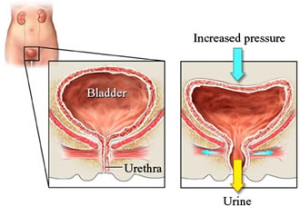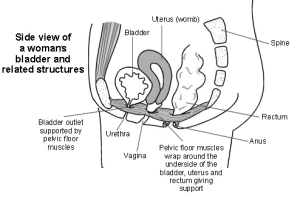Stresss Incontinence
Stress Incontinence is not a normal part of ageing. You do NOT have to put up with it.

What is stress incontinence?
When your pelvic floor muscles are so weak that they cannot endure the increased pressure, urine in the bladder leaks without your intention to void. This is called stress incontinence. Stress incontinence is more common in older women. Childbirth and other events injure the supports of the bladder causing stress incontinence. It increases during menopause or a week before menstruation due to low oestrogen levels.

Understanding urine and the bladder
Urine is made in the kidney constantly, which is stored in the bladder. The amount of sweating, eating and drinking contributes to the amount of urine.
The bladder is made of muscles. As the urine enters the bladder it inflates like balloon. With help from the muscles, the outlet is kept closed so the urine cannot leak out.
When you go to the toilet to void, the bladder muscle contracts to push urine out of the bladder, while at the same time pelvic floor muscles relax.
What causes stress incontinence?
Pelvic floor muscles are contributing to control of the movements of the bladder by folding the bladder and rectum. Stress incontinence can emerge if the pelvic floors are too weak to have control over the movements. In addition some of the supporting tissues under the urethra can become deficient causing the urethra to drop down with coughing or straining. This prevents a natural kinking mechanism in the urethra from preventing urine exiting the bladder.
Childbirth is the most common cause of the weakening of pelvic floor muscles and suburethral tissue, which leads to stress incontinence.
As you are ageing the muscles and vaginal tissues become weaker, particularly after the menopause. Another cause of Stress incontinence is obesity.

Can stress incontinence be prevented?
Doing regular pelvic floor exercises during pregnancy and after child birth can help to reduce the risk of weakening the pelvic floor muscles and hence stress incontinence.
The pelvic floor muscles are a group of muscles that wrap around the underside of the bladder and rectum.
It is important that you exercise the correct muscles. This is why a physiotherapist can help.
Some general lifestyle measures which may help
• Your GP may refer you to the local continence advisor/ physiotherapist. Continence advisors can give advice on treatments, especially pelvic floor exercises. If incontinence remains a problem, they can also give lots of advice on how to cope. For example, they may be able to supply various appliances and aids to help such as incontinence pads etc.
• Getting to the toilet. Make this as easy as possible. If you have difficulty getting about, consider special adaptations like a handrail or a raised seat in your toilet. Sometimes a commode in the bedroom makes life much easier.
• Obesity. It is known that stress incontinence is more common in women who are obese. If you are obese, losing weight may help to ease the problem.
• Smoking can cause cough which can aggravate symptoms. Smoking also increases the aging process of vaginal tissues causing prolapse and incontinence.
What are the treatment options for stress incontinence ?
1 Non-surgical such as pelvic floor exercises, insertion of tampon at the time of activities. Medication may be advised in addition to pelvic floor exercises if a surgery is not desired or not appropriate.
2 Surgical treatment this can be performed vaginally or laparoscopically. The surgery may involve usage of permanent material called mesh (sling)
3 Injectables: a collagen material is placed around the bladder neck.
